Disclaimer: This blog is purely recreational and not for profit. Any material, including images and/or video footage, are property of their respective companies, unless stated otherwise. The authors’ claim no ownership of this material. The opinions expressed therein reflect those of the authors and are not to be viewed as factual documentation
Make Mine Music is Disney’s third package film, the eighth in the canon and its first post-war release. Produced in the midst of the Second World War, Disney had lost a lot of their manpower and their resources, and thus Make Mine Music is made up primarily of unfinished ideas that were perceived either as too long for shorts or too short for features. The studio continued to adapt to their turbulent situation in order to survive, and Make Mine Music is a clear example of their astounding flexibility and adaptation. The film is similar to Fantasia, consisting of episodic animated musical sequences, albeit it is not as grand as Fantasia. It had been Walt Disney’s dream to make numerous Fantasia-like films in his lifetime, and while that wasn’t to be, Make Mine Music is close to that musical format. Instead of classical music, the film is underscored mainly by modern music, featuring popular artists of the time such as The Andrews Sisters, the King’s Men, Benny Goodman and his Orchestra, Andy Russell, Dinah Shore, Nelson Eddy, Jerry Colonna and the Ken Darby chorus.
The film also features famed sequence based upon Sergei Prokofiev’s Peter and the Wolf. Sergei Prokofiev had told Walt Disney that he was mesmerised by Fantasia and would love to see such an adaptation of one of his own compositions, in this case, Peter and the Wolf, which had not been performed in public at that stage. Walt Disney was touched, but felt downcast as he knew there would not be another instalment of Fantasia.
We will dive right in! However we have some tragic news … we cannot find an original trailer for Make Mine Music.

Any trailer we have come across is not from the film’s original release. Sad! If anyone knows if there is access to one, please post a link. In the meantime, let’s get on with the film:
Both Saludos Amigos and The Three Caballeros were comprised of animated shorts, loosely linked together through some form of framing device. These had a tendency to be a little uneven, and at times just outright clumsy, which meant that they were counterproductive to the fluidity of the films. Make Mine Music dispenses with any sort of framing device, and simply shows one animated short after another. This makes sense as there is not really any connection between any of the sequences, from a thematic perspective at least.
The film opens by running down a list of all the vocalists and performers who feature, with their names up in lights outside a grand movie theatre. The days when the voice actors went uncredited are now long gone. They now sell the movie! This culminates with the reveal of the film’s title, accompanied by the appropriate song.
The Martins & The Coys – The King’s Men
The opening sequence tells the story of two rival hillbilly families (both alike in ‘dignity’ in fair random forest where we lay our scene, etc.), who get into some incredibly trigger-happy shoot-outs with one another. Naturally it is only so long that this kind of lifestyle can last, and sure enough both families wind up floating on separate clouds.
Yes they all died!
(Special Note from Melissa: Watching these bickering families still bickering in the clouds did instantly send my mind to a film made more than seventy years later:)
Not that this does anything to blunt the rivalry, and the spirits eagerly watch on, as the single surviving members of each family prepare to come to blows. The two left living turn out to be a man and a woman, and rather than shooting one another they fall in love instead. He is ready to shoot but immediately stops in his tracks when he sees how attractive she is. To us children of the Disney Renaissance, this sounds familiar:
Luckily John Smith had also seen Make Mine Music
(Special Note from David: Which is especially miraculous, considering that cinema didn’t exist in that time!)
Ah the start of a healthy relationship … and some foreshadowing?
Did this trigger-happy lady reincarnate into Tinkerbell? Or vice versa?
They have themselves a rootin’-tootin’ hootenanny of a time at a local barn dance. Woo.
(Special Note from David: This particular bit went on a bit too long for my liking, as there wasn’t really anything to it).
(Special Note from Melissa: It does not help that the animation becomes very choppy in style and pacing during that moment)
Or that the band looks super bored … or zoned out
The ghosts of their dead relatives can do nothing but look on incredulously as the two get married. But there is a twist at the end, when it is revealed that the newly-weds like nothing better than a good old fashioned fist fight. Ah the rivalry goes on. It is like a ‘What if Romeo and Juliet Had Survived’ scenario; perhaps the star-crossed lovers would have lived up to the Montague and Capulet rivalry, just like the Martins and the Coys … hmm subtle name choices. We see what you did there Disney.

Overall the sequence features silly slapstick humour and a couple of laughs, but there are definitely better sequences on offer in the film. Nothing special.
Blue Bayou – The Ken Darby Chorus
There is a sudden seismic shift in animation quality with Blue Bayou which is the most visually striking sequence since the Golden Age.
Such a delightful visual treat to see while wading through package film territory!
This is not all that surprising though, as the scene was originally made to be a part of Fantasia accompanied by the beautiful ‘Clair de Lune’. It was cut from Fantasia for time. Check it out if you can; it is wonderful and sublime in its original form. When viewed in such a way there is a much clearer synchronicity between the music and the visuals, than in the version within this film. As it is, the sequence is very beautiful, but it really deserves to be seen as it was first intended in order to be fully appreciated. But overall, in this film it still hits the spot – calming and lovely!
All The Cats Join In – Benny Goodman and his Orchestra
After the serene and peaceful mood of Blue Bayou there is a lively and fast paced jazzy number to pick the pace right back up again. The artwork is of a very different style to anything previously seen within a Disney film, and is presented in very entertaining and inventive way: the artist’s pencil frantically creates the scene as it plays out (in a similar manner to Aquarela do Brazil from Saludos Amigos – except there it was a paintbrush).
It ‘helpfully’ points out that ‘cats’ do not refer to literal cats.
Thanks for that …
The scene shows a group of teenagers getting caught up in the rhythm of the music played by the jukebox. A boy calls what we assumed to be his mother and little sister initially:
Turned out to be his date … awkward
There is a little bit of cheekiness as a girl strips off and leaps into the shower, before dancing around with her towel and redressing.
Just give me the T-shirt already!
There is also some crazy driving within a car that can carry a seemingly unlimited number of passengers …
“Kicking in the front seat, sitting in the back seat …”
(Special Note from David: This caption was not approved by me!)
(Special Note from Melissa: Can’t stand the song but couldn’t resist it!)
They eventually arrive at the diner that serves the finest Malt in town.
This is where the cool kids hang out … it looks rubbish
They then proceed to dance around with great abandon, and in a manner that only really works in a cartoon.
This would be a marvellous image if it weren’t for those gaping soulless empty eye sockets!
(Special Note from David: This was probably my favourite sequence from the film, and I really like the fact that all of this iconographic imagery which we associate with the 40s and 50s from a contemporary perspective, was captured here during a time when it was actually current – I think that actually lends the scene an extra layer of charm)
(Special Note from Melissa: Likewise I thought the iconography was really enjoyable. In a funny way, although it was made in the 1940s, it has a real 1950s feel from our modern eyes. Back to the Future, Grease and Pleasantville went through my mind a lot. Perhaps they could have added a Biff Tannen figure for conflict!)
Although it comes close when they throw this poor guy out, who looks like a tiny cartoon version of Bert in Mary Poppins, likely for being a ‘square’.
Don’t worry Bert. You’ll get the better of them! See who’s the ‘square’ now! At least your date has eyeballs.
Overall, this was an enjoyable fast-paced sequence with quirky animation for Disney’s standards and superbly fun music from Benny Goodman.
Without You
After such a frenetic-paced sequence, it is a surprise when the sombre mood returns with another short, moody sequence that is accompanied by crooning vocals. The perspective carries the viewer through a bedroom window and into the world outside, where rain and snow melt off the camera revealing a forlorn looking tree. There is a pretty night sky filled with stars, which then segues into the pink glow of early morning, and then the perspective pulls back through the window once more. It is a sweet-natured and rather melancholic, sad little scene, reflective of the overall mood within the animation studio at the time (World War II was reaching its end). It is the shortest sequence, and is so fleeting that it could pass you by, like a tiny poem or painting (all about isolation, loss and the passage of time). It seems more like an interlude than a full sequence.
Casey At The Bat – Narrated by Jerry Colonna
Once again there is a shift in tone, as melancholy gives way to comedy. Casey At The Bat, based on the 1888 poem by Ernest Thayer, tells the story of a famous baseball player – who draws crowds from all around – whose arrogance and self-assured nature proves to be his own undoing – a ‘The Hare and the Tortoise’ type of narrative, or in this case Casey and the Incompetent Baseball Players.
Like this fine fellow who gets his moustache caught on his bat …
Or perhaps Casey and the Terrifying Baseball Fans
There seemed to be nostalgia for the turn of the century during the 1940s, primarily in the form of baseball movies:
We get this dubious line: ‘The ladies don’t understand baseball a bit / They don’t know a strike from a foul or a hit / But when they see Casey the game has got it’
(Special Note from Melissa: We had to rewind that to check that we had heard that properly!)
The scene builds up towards the moment when Casey steps up to bat, which he does amidst much fanfare and admiration from the ladies in attendance.
A real precursor to future charmers like Gaston!
(Special Note from Melissa: Do the predominantly male Disney animators just assume that this is the kind of man women fancy? Moronic men with ginormous chins?)
He allows the first two balls to go by without even attempting to hit them …
He has more pressing issues on his mind, like busty ladies
… building towards the climax of the scene when the pitcher throws the ball and… things go a bit odd for a moment, and it almost seems to be suggesting that Casey had died (!) before it is revealed that he struck out, and he is shown bawling on a rain soaked field, haplessly attempting to hit the ball over and over again. Ouch.
This sequence is similar to the Martins and the Coys sequence in both art style and tone, and it is probably the superior of the two – containing more laughs and being more memorable overall.
Two Silhouettes – Dinah Shore
This is another Fantasia-esque sequence in which two ballet dancers (Tania Riabouchinska and David Lichine) are shown in silhouette, whilst two cupid-angels hover around them. As with the previous atmospheric scenes, there is a nice visual panache to Two Silhouettes and the picturesque style compliments the dancers’ abilities very well. One moment in particular stands out, as the cupids lift the female dancer up into the air, allowing her to dance on the clouds.
Gorgeous
It is a short simple sequence but the animation is lovely, emulating the grace and elegance of ballet. The dancing is initially a tad stilted (and the cupid babies are a bit distracting) but once the female dancer is up in the clouds, the radiance of the scene shines through! Dinah Shore’s vocals emotionally swell throughout the scene, heightening the sequence’s passion.
Peter and the Wolf – Sergei Prokofiev and Sterling Holloway
The most famous scene from Make Mine Music is clearly Peter and the Wolf. Narrated by Sterling Holloway (fancy seeing you again!) the scene starts with an explanation as to how each character within the story is represented by a different instrument.
(Special Note from David: Although Sterling helpfully neglects to tell us which instrument signals the arrival of the wolf, so we’ll be good and unprepared!)
Young Peter is about to make his way into the forest to hunt down the wolf, when he is halted by his Grandfather who warns him against such a foolhardy venture:
‘You’ll shoot your eye out kid!’
Special Fact from Melissa: A Christmas Story does use music from Peter and the Wolf:
Undeterred by this, Peter heads out anyway and meets up with his friends Sasha the bird, Sonia the duck and Ivan the cat. There is some scuffling twixt bird and cat, but then the wolf appears, and things get serious. The wolf is quite a sinister presence, and is mostly shown in extreme close-up, bearing down on the camera with its huge mouth opened wide.
Arghhhhhhhhhhhhhhhhhhhhhhhhhhhhh!
A supremely elaborate fake-out then ensues, as the pretence that Sonia gets eaten by the wolf is established …
… and then followed through to such a dramatic extent that she is actually shown entering the gates of heaven (Special Note from David: My initial reaction was that it must be a fake-out, but they went so far with it that I actually took the bait). With one member of the hunting party down, the sense of threat is now very severe. The animators then tease potential further casualties, before the arrival of a trio of hunters. It is lucky they got there when they did, as they arrived just in time to … see that Peter had already caught the wolf.
Sterling Holloway: ‘Oh happy days! I think I’ll say that again. OH HAPPY DAYS! … everybody’s happy, except the wolf!’ Bizarrely enough the wolf is smiling throughout this moment …
There is then much celebrating amongst the townspeople, but not for Sasha, who is left to mourn the death of his friend Sonia … who it turns out was hiding in a tree-trunk all along.
(Special Note from David: Should I call this a fake-out or a cop-out?)
After You’ve Gone
The second Benny Goodman sequence of the film (the first being All The Cats Join In) then acts as a transition between two of the lengthier sections. After You’ve Gone is a fun little scene in which a group of musical instruments dance around in a style that imitates human behaviour. It is an energetic, creative sequence, with plenty of bright colours, and a toe-tapping jazz tune accompaniment. There are a few surreal visuals in there, perhaps mild leftovers from The Three Cabelleros:
Like these fingers / legs!
It is certainly the film’s most abstract sequence, short in length, but it jazzily and joyfully anthropomorphises those instruments, echoing Pink Elephants on Parade in style without the massive headache of The Three Caballeros.
Johnnie Fedora and Alice Blue Bonnet – The Andrews Sisters
The Andrews Sisters provide the accompaniment for the penultimate scene, which tells the story of two hats in an urban department store, who fall in love but are separated when they are bought by different customers.
Just after Johnnie fantasised about the possibilities of married life
The animators do a very good job in generating sympathy for Johnnie, who is surprisingly expressive despite not actually having a face, and he goes through quite an ordeal throughout his journey: He is crushed, stepped on, savaged by dogs, nicked by a tramp, almost slips into a sewer and ultimately gets holes cut in him so that he can be worn by a horse. Despite all this hardship, it is a simple love story that is very charming and thankfully has a lovely pay-off.
Because the story seems to be told more from Johnnie’s point-of-view, it means that Alice is given less attention in terms of expressiveness, which is a pity as it would have been interesting to have seen more of her anguish during their cruel separation (a missed opportunity it seems!). She is mainly presented as a pretty face, and the object of Johnnie’s affection. However the love story is still engaging, it is a sweet creative idea and the Andrews Sisters are a delight!
The Whale Who Wanted To Sing At The Met – Nelson Eddy
The film closes out with its longest sequence, which tells the story of an opera singing Whale. Yes, that’s right an opera singing Whale! Willie the Whale is very quickly established as a likeable character, who delights all of his friends with his singing, and then heads off to seek fame and fortune when he gets wind of the newspaper headlines.
He makes his way to a boat occupied by the impresario Tetti-Tatti, and begins to perform operatic sonatas. Tetti-Tatti, upon hearing the Whale’s miraculous ability to sing Tenor, Baritone and Bass arrangements simultaneously, is firm in his belief that Willie must have swallowed three opera singers. He rushes to the harpoon gun, but the sailors – who are entranced by the singing voice – wrestle him away.
Then Willie is shown performing different operas at the Met, inspiring awe and wonder from everyone in attendance.
The image of Willie – whose physical presence literally fills the theatre – taking a bow at the end of his performance is simultaneously amusing and terrifying.
Argh! Don’t lose your balance!
(Special Note from Melissa: Knowing this was a tragedy, I kept thinking, please don’t fall down and crush the audience, leading to the end of Willie’s career and life)
It all seems too good to be true, and unfortunately that is the case, as it is revealed that all of Willie’s performances at the Met were just a dream. Willie’s portrayal of Mephistopheles is interrupted by reality, when Tetti-Tatti fires the harpoon gun at Willie, tragically killing him.
(Special Note from Melissa and David: Since both of us are actors, we have learned that perhaps it is best to book an appointment for an audition, rather than show up and start performing unasked, lest we get gunned down by some marvellous director!)
The scene – and also the film – ends on this rather sad note, with the narrator declaring that “Willie was a miracle, and people just aren’t used to miracles”. The ending is bittersweet as we see Willie singing in heaven, with a ‘Sold Out’ sign on the pearly gates. It really works as a standalone short. The tragic conclusion offers a cynical view of the world without preaching and attacking the world for what it is. Maybe this was why they changed the originally sad ending to Peter and the Wolf. Nelson Eddy was a huge opera star and he does a magnificent vocal performance, doing the all of the voices in the short, ranging from bass all the way to soprano (that is a talented individual right there!). It is impressive, marking it as one of the strongest shorts in Make Mine Music (perhaps even all of the package films! Will have to wait and see). The short features some amusing visual gags, ranging from the wacky newspaper headlines to the audience with papers over the heads as the birds fly above them to Willie’s elaborate costumes. Comedy and tragedy shine through in this excellent short.
David’s Verdict:
Make Mine Music is easily the most enjoyable of the package films (thus far at least, I’ll have to see what the rest are like). Within each of the ten shorts there was something to enjoy – whether it be design elements, humour or the music itself – and the variety of styles and moods allowed for the pacing to flow smoothly. I mentioned earlier that my favourite sequence was All The Cats Join In because it was a fun, energetic piece, with a lively score and an artistic style that I particularly enjoyed (even though it wasn’t typically ‘Disney’ artwork). The 1940s setting, the colourful ice-cream and milkshake diner, the exuberant dancing; they all worked really nicely.
I also thought that The Whale Who Wanted To Sing At The Met was a very strong sequence, and I have to praise the stellar vocal performance of Nelson Eddy. I have mentioned before that I will always give praise to Disney films that are willing to take risks and make bold decisions, and the ending to this scene – along with the accompanying message – is perhaps one of their boldest to date. The misunderstood protagonist, of miraculous talent, does not get to realise his dream – and his glorious singing voice is forever lost to the world. The fact that the film ends on this note is especially profound, leaving the audience with the parting thought that things don’t always work out, no matter how much they want them to. For a company that specialises in fairy tales and wishes coming true, it is a more realistic – albeit cynical – outlook on the world. Perhaps this was due to the ending of the Second World War, and the effect it had on the mindset of many of the animators.
Overall Make Mine Music was an enjoyable film, and a significant improvement over its package-film-era predecessors. I would call it a more audience accessible version of Fantasia, and in a similar vein to my views on Fantasia there are individual scenes that I would watch again, but I probably wouldn’t need to watch the film in its entirety again anytime soon.
Melissa’s Verdict:
Make Mine Music is a snappy little film that is episodic to the core, featuring ten individual shorts, whose only relation to each other is that they are animated and set to music. Unlike the previous two films which had Latin America as their anchor, this film feels like a collection of short stories without a primary theme. This does not make it a bad film (in fact it is a refreshing change of pace from Saludos and Caballeros). It is enjoyable to watch, feeling like an insight into the animators simply having a play by experimenting with different styles and ideas, fundamentally like an animation buffet. Sometimes you prefer it when the meal that you want comes straight to you, with beautiful composition and high quality taste, and yet it can also be fun to splatter ‘whatever’ on your plate, to try a bit of everything.
Of all the different animation ‘samples’, I found myself drawn to the sequences depending on the musical performer. I already enjoy the music of The Andrews Sisters and Benny Goodman and his Orchestra, therefore their respective sequences really entertained me. All the Cats Join In is so different from what I have seen from Disney (though I must admit I can’t get used to those characters with empty eye sockets!). It is scrappy in style, almost like a work-in-progress, but the sequence is bursting with vigour, energy and delightful 1940s iconography, marking it as an entertaining sequence. The Johnnie Fedora and Alice Blue Bonnet scene had such a catchy tune (The Andrews Sisters are always catchy to the core!) and a genuinely moving message about true love. I can imagine that Disney’s recent urban animated short Paper Man was inspired by this short. Nelson Eddy’s voices in the final short were simply astounding; what a talented man! The film’s decision to end on such a tragic note was a bold move, although thankfully bittersweet rather than horrific. It is the closest of all the sequences to a powerful stand-alone short.
The other shorts were pleasant enough and creative in their own ways (some more than others!). I still believe that Blue Bayou is much better set to the classical Clair de Lune, but the animation is still sublimely beautiful. I would not be racing to watch Make Mine Music again, but I am glad that I have seen it. I do look forward to Disney’s ‘sit down dinners’ again once we hit 1950, as we make our way through this endless all-you-can-eat buffet of package films.
Legacy:
Although Make Mine Music was not nominated for an Academy Award (unlike the previous two package films), the film won two awards at the first ever Cannes Film Festival in 1946, for Best Animation Design and Grand Prize of the Festival. While the film performed reasonably well at the box office, Make Mine Music received mixed criticism; allegedly audiences and critics were growing tired of the package film format and were itching for traditional storytelling again. Critic, Bosley Crowther, yet again epitomises the critical feeling of the time: ‘Mr. Disney and his dexterous crew have packed ten distinctive cartoon subjects of varying character and length, some of them thoroughly delightful and some of them ponderous and dull. No artistic pattern associates the lot. They are just so many short subjects. You pays your money, and you takes your pick’. Walt Disney himself was allegedly disappointed with the final result of Make Mine Music, likely because to him it felt so below par in relation to his musical magnum opus, Fantasia. A classical purist, Walt really had to be persuaded to make this film by his brother (appeased by the inclusion of one classical segment, Peter and the Wolf).
In 1970, at a Disney retrospective, David Rider wrote that Make Mine Music had been ‘unfairly described as the “poor man’s Fantasia”. Today the film is likely the least known in Disney’s canon (again it did not even have a DVD release in the UK until this year). It has never been re-issued as a cinematic release, although individual segments were broadcast on television. The film marks the first time that a Disney feature film credits the performers before the title itself. A milestone! They are continuing to become much more of a selling point. There has been controversy surrounding the editing of the film. The Martins and the Coys sequence had been deleted from previous VHS and DVD releases due to ‘comic gunplay’. Strange considering the amount of trigger happy characters in many Disney films (and this does not apply purely to villains, the Widow character from The Fox and the Hound purposefully shoots her neighbour’s car radiator) However on the UK 2013 DVD release, the sequence was restored.



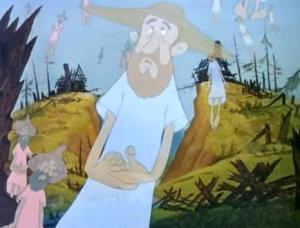











![snapshot_dvd_00.08.00_[2011.03.28_22.16.25]](https://thedisneyodyssey.files.wordpress.com/2013/11/snapshot_dvd_00-08-00_2011-03-28_22-16-25.jpg?w=300&h=199)
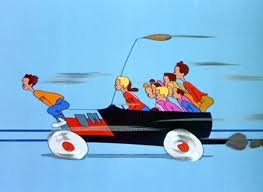






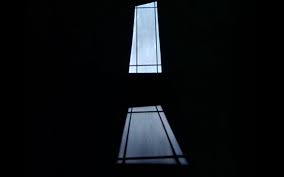
![snapshot_dvd_00.17.15_[2011.03.28_22.23.23]](https://thedisneyodyssey.files.wordpress.com/2013/11/snapshot_dvd_00-17-15_2011-03-28_22-23-23.jpg?w=300&h=199)




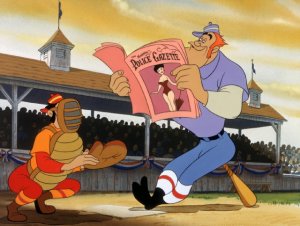


![snapshot_dvd_00.25.52_[2011.03.28_22.25.15]](https://thedisneyodyssey.files.wordpress.com/2013/11/snapshot_dvd_00-25-52_2011-03-28_22-25-15.jpg?w=300&h=200)






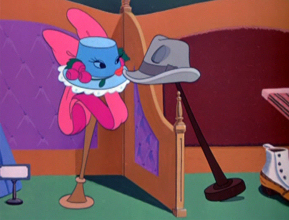
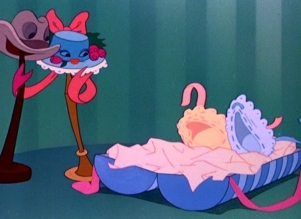







Great review!
I quite enjoy this film and find it very likable…WAY more than “Fantasia”!
The first sequence, “The Martins & the Coys” is actually cut out from the DVD editions (at least in America) because it’s deemed to have “too much gunplay”.
My favorite sequence is the “Johnnie Fedora and Alice Bluebonnet” sequence and the ballad is actually my favorite Disney song in the entire Canon. You can see that Pixar used this short as inspiration for their “The Blue Umbrella” short.
Thanks! Yes we mentioned that in the last paragraph (in the legacy section, on ‘comic gunplay’). Although it is still cut from the US DVD, on the UK/European DVD it has been restored, but then again that DVD was only released this year. We can see why it was cut but at the same time it does not seem particularly offensive.
Will have to check The Blue Umbrella out!
Reblogged this on Blog do Rogerinho.
The tale , although well known, is moving and the character design is spectacular, as well as the music by the Philharmonic. There isn’t a word of dialogue by the human characters, but their feelings and thoughts come through crystal clear through facial expressions, and in the case of Peter, the boy’s large expressive eyes.
Pingback: Ranking the Magic: The Package Age – Lost in the Itchy Lot